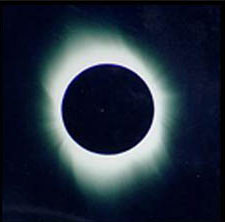
Source: Lunar Eclipse,
Stephen Gray, Think Quest

Source: Lunar Eclipse,
Stephen Gray, Think Quest
An eclipse occurs when the shadow of one celestial body falls on another celestial body.
There are two kinds of eclipses - lunar and solar.
A lunar eclipse happens when the Earth moves between the sun and the moon, blocking part of the sun's light from reaching the moon. During a lunar eclipse, you will see the Earth's shadow on the moon. During a lunar eclipse, which can last up to an hour and a half, the moon may turn a reddish color. Since the moon does not produce its own light, it is not dangerous to look at a lunar eclipse. The image to the right shows a time lapse of a lunar eclipse.

Source: Solar Eclipse,
James Funkhouser, Think Quest
Solar eclipses occur when the moon is positioned between the Earth and the sun. Because of the moons position, part of the sun’s light is blocked. As the moon moves in front of the sun the sky becomes dark. A total eclipse, which is extremely rare, occurs when the moon and sun are in perfect alignment. The image to the right shows what you see from Earth during a total eclipse. During a total eclipse, all you can see from Earth is a ring of light around the moon, which is the part of the sun the moon did not cover. It is very dangerous to look directly at a solar eclipse even while wearing sunglasses. It is safest to view solar eclipses through a pin-hole projector.